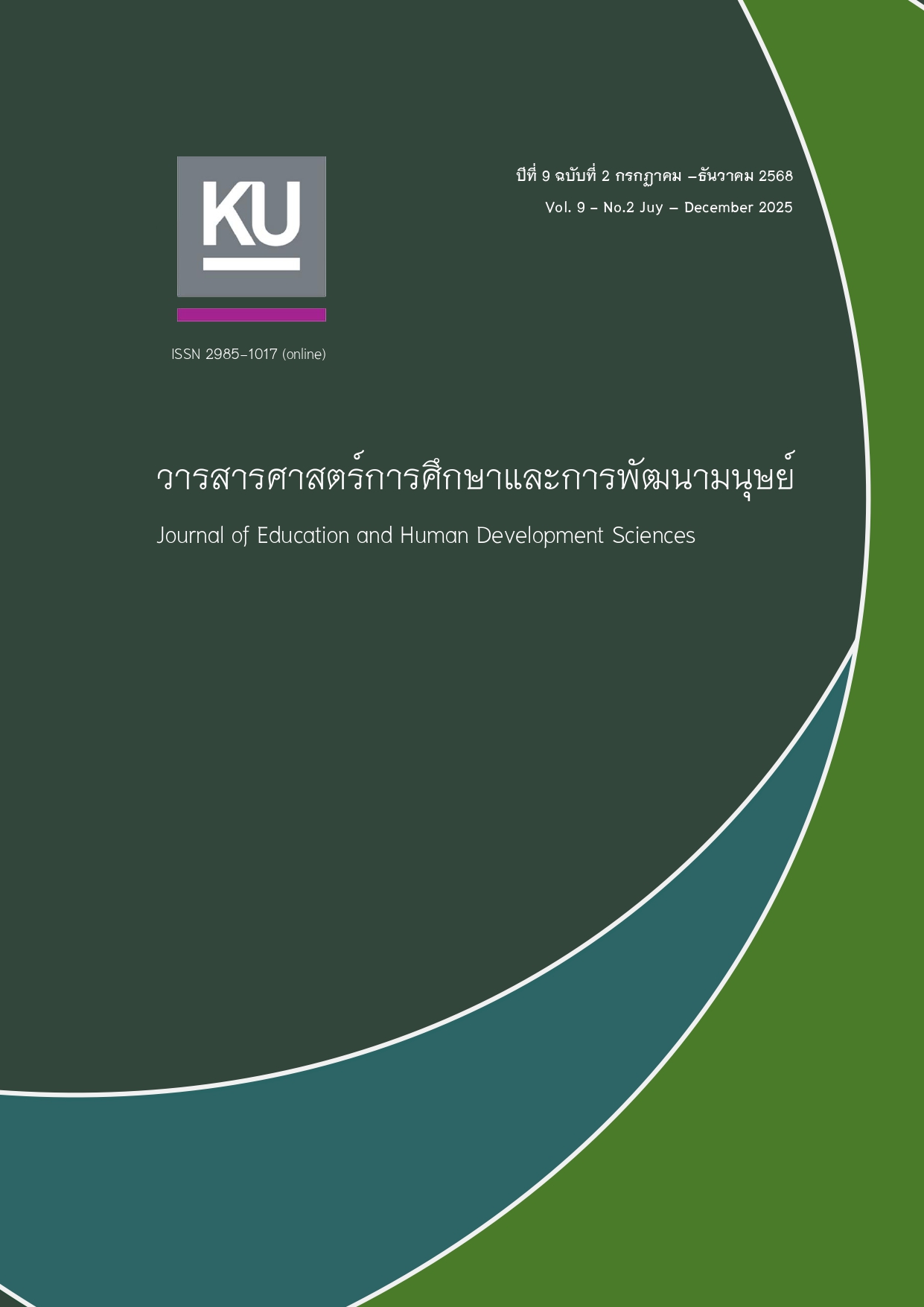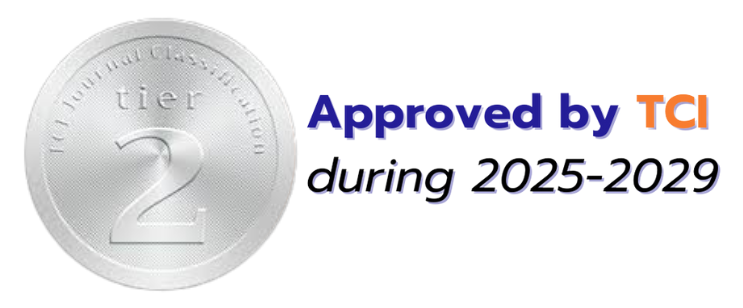ปัจจัยที่ส่งผลต่อพฤติกรรมการกลั่นแกล้งของนักเรียนชั้นมัธยมศึกษาตอนต้น โรงเรียนสาธิตแห่งมหาวิทยาลัยเกษตรศาสตร์ วิทยาเขตกำแพงแสน ศูนย์วิจัยและพัฒนาการศึกษา
关键词:
พฤติกรรมการกลั่นแกล้ง, นักเรียนชั้นมัธยมศึกษาตอนต้น摘要
การวิจัยนี้มีวัตถุประสงค์เพื่อ 1) ศึกษาระดับพฤติกรรมการกลั่นแกล้งของนักเรียนชั้นมัธยมศึกษาตอนต้น 2) ศึกษาระดับปัจจัยที่ส่งผลต่อพฤติกรรมการกลั่นแกล้งของนักเรียนชั้นมัธยมศึกษาตอนต้น และ 3) ศึกษาปัจจัยที่ส่งผลต่อพฤติกรรมการกลั่นแกล้งของนักเรียนชั้นมัธยมศึกษาตอนต้น กลุ่มตัวอย่างที่ใช้ในการวิจัย คือ นักเรียนชั้นมัธยมศึกษาตอนต้น โรงเรียนสาธิตแห่งมหาวิทยาลัยเกษตรศาสตร์ วิทยาเขตกำแพงแสน ศูนย์วิจัยและพัฒนาการศึกษา จำนวน 240 คน โดยใช้วิธีการสุ่มตัวอย่างแบบง่าย เก็บรวบรวมข้อมูลด้วยแบบสอบถาม สถิติที่ใช้ในการวิเคราะห์ข้อมูลได้แก่ ความถี่ ร้อยละ ค่าเฉลี่ย ส่วนเบี่ยงเบนมาตรฐาน วิเคราะห์โดยใช้สัมประสิทธิ์สหสัมพันธ์ของเพียร์สัน และการวิเคราะห์การถดถอยพหุคูณแบบขั้นตอน
ผลการวิจัยพบว่า 1) ระดับพฤติกรรมการกลั่นแกล้งของนักเรียนชั้นมัธยมศึกษาตอนต้น โดยภาพรวมอยู่ในระดับมาก 2) ระดับปัจจัยที่ส่งผลต่อพฤติกรรมการกลั่นแกล้งของนักเรียนชั้นมัธยมศึกษาตอนต้นโดยรวมอยู่ในระดับปานกลางทั้ง 7 ตัวแปร ประกอบด้วย การเห็นคุณค่าในตนเอง ความคับข้องใจ สัมพันธภาพระหว่างนักเรียนกับเพื่อน สัมพันธภาพระหว่างนักเรียนกับครอบครัว สัมพันธภาพระหว่างนักเรียนกับครู การใช้สื่อออนไลน์ และความเชื่อทางศาสนา และ 3) ปัจจัยที่ส่งผลต่อพฤติกรรมการกลั่นแกล้งของนักเรียนชั้นมัธยมศึกษาตอนต้น มีจำนวน 3 ตัวแปร ได้แก่ สัมพันธภาพระหว่างนักเรียนกับเพื่อน สัมพันธภาพระหว่างนักเรียนกับครอบครัว และการใช้สื่อออนไลน์ โดยร่วมอธิบายพฤติกรรมการกลั่นแกล้งของนักเรียนชั้นมัธยมศึกษาตอนต้นได้ร้อยละ 21.2 ที่ระดับนัยสำคัญทางสถิติ .001 และสามารถสร้างสมการพยากรณ์พฤติกรรมการกลั่นแกล้งของนักเรียนชั้นมัธยมศึกษาตอนต้น ในรูปคะแนน Y ̂=2.455 + 0.168X_3 + 0.316X_4 + 0.161X_6 และสมการพยากรณ์ในรูปแบบคะแนนมาตรฐาน (Z_y ) ̂=0.185Y_x3 + 0.331Y_x4 + 0.215Y_x6
Downloads
参考
Arayawinyu, P. (1999). Education for children with special needs (2nd ed). Waen Kaew Publishing.
Atsakun, S. (2010). Family Institution: Development and Change. Chulalongkorn University Press.
Chanrod, A. (2022). A study of the severity of bullying behavior among students in Secondary Schools of Mueang District in Phitsanulok Province. Journal of Local Management and Development, Pibulsongkram Rajabhat University, 2(1), 43-56.
Faculty of Mass Communication, Ramkhamhaeng University. (2020). The Department of Mental Health reveals that Thai children are ranked 2nd in the world for bullying in schools. https://mac.ru.ac.th/ramintouch.
Damrongkiattisak, W., Achapetch, N. & Chamnankha, D. (2014). Learning achievement between using of print media and interactive multimedia of primary and secondary school students. Journal of Humanities and Social Sciences, 22(38), 135-160.
Department of Mental Health, Ministry of Public Health. (2019). Stop bullying, stop violence in society. https://dmh.moph.go.th/news-dmh/view.asp?id=30024.
Kaewwiset, P., Matayaboon, N., Somboon, L. & Kodyee, S. (2021). Cyber bullying behavioral and related factors of high school students in Muang District, Chiang Rai Province. Journal of Buddhist Social Sciences and Anthropology, 6(5), 239-253.
Kitsukchit, P. (2016). The factors causing adolescent female bullies in secondary girls’ schools in the Nangkok Metropolis According to Ronaid L. Akers’s Social Learning Theory. Journal of Library Services, Prince of Songkla University, 27(1), 72-80. DOI: http://dx.doi.org/10.14456/asj-psu.2016.8
Laeheem, K. & Sangkharat, U. (2013). Guidelines for solving bullying behavior problems of students in private Islamic schools in Songkhla Province. Faculty of Liberal Arts, Prince of Songkhla University, Hat Yai Campus.
Laeheem, K. (2014). Factors related to students: Bullying behavior of students in Islamic private schools, Songkhla Province. Srinakharinwirot Journal of Humanities and Social Sciences, 6(12) , 14-30.
Sittichai, R. & Tudkeo, T. (2017). Cyberbullying behavior among youth in the three southern border provinces. Journal of Library Services, Prince of Songkhla University, 28(1), 86-99.
Wutthisawat, S. (2009). A study of family relationships among students in grade 2 (Master's thesis in Guidance Psychology, Srinakharinwirot University).
Wibulseth, S. (1999). Relationships among Thai family members. Journal of Demography, 15(1), 37-50. https://doi.org/10.56808/2730-3934.1199
Downloads
已出版
期
栏目
License
Copyright (c) 2025 วารสารศาสตร์การศึกษาและการพัฒนามนุษย์

This work is licensed under a Creative Commons Attribution-NonCommercial-NoDerivatives 4.0 International License.







